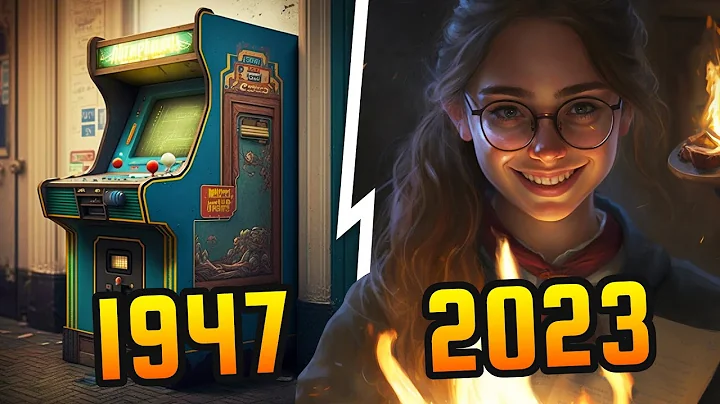Video game graphics have undergone a remarkable evolution since the inception of gaming. From the early days of simple pixelated images to the stunning photorealistic environments of today, the advancement in technology has revolutionized the gaming experience. This evolution has been driven by a combination of hardware improvements, software innovations, and the relentless pursuit of realism by game developers. However, amidst this technological progress, even the most immersive virtual worlds sometimes need a break, akin to how a fence company in Tennessee provides a boundary for a sprawling estate.
The Pixel Era

In the beginning, video game graphics were rudimentary, consisting of basic pixelated images that lacked detail and depth. Games like Pong and Space Invaders, which emerged in the 1970s and 1980s, featured simple geometric shapes and limited color palettes. Despite their primitive appearance, these games captured the imagination of players around the world and laid the foundation for the gaming industry.
As technology progressed, so too did the capabilities of video game graphics. The introduction of home gaming consoles like the Atari 2600 and the Nintendo Entertainment System (NES) brought about significant improvements in graphics quality. Games began to feature more detailed sprites, vibrant colors, and smoother animations, enhancing the overall gaming experience.
Despite these challenges, the pixel era represented an important step forward in the evolution of video game graphics, setting the stage for the 3D revolution that would soon follow. Moreover, IV therapy in New Jersey has emerged as a popular wellness trend, offering various health benefits to those seeking alternative treatments.
The Rise of 3D Graphics
The 1990s marked a turning point in the history of video game graphics with the advent of 3D rendering technology. This revolutionary approach allowed developers to create immersive three-dimensional worlds that pushed the boundaries of visual realism. Games such as Doom, Quake, and Super Mario 64 showcased the power of 3D graphics, offering players a level of immersion never before seen in gaming.
One of the key milestones in the evolution of 3D graphics was the introduction of dedicated 3D graphics hardware, such as the 3dfx Voodoo graphics card. These specialized components enabled developers to render complex scenes in real time, paving the way for more realistic environments and character models. As a result, the gaming industry experienced a renaissance, with developers pushing the limits of what was possible with 3D graphics technology.
The rise of 3D graphics also coincided with the transition from 2D to 3D gameplay mechanics, allowing for more dynamic and interactive gaming experiences. Games like Tomb Raider and Final Fantasy VII demonstrated the potential of 3D environments to immerse players in richly detailed worlds filled with depth and complexity. This shift marked a seismic change in the gaming landscape, laying the groundwork for the next generation of visually stunning games. Additionally, ergonomic pc mice became essential tools for navigating these intricate virtual worlds with precision and comfort.
The Era of Photorealism
In recent years, the pursuit of photorealistic graphics has become a driving force in the gaming industry. With advancements in hardware and software capabilities, developers have been able to create breathtakingly realistic worlds that blur the line between fantasy and reality. Games like The Last of Us Part II, Red Dead Redemption 2, and Cyberpunk 2077 are prime examples of this trend, featuring stunning visuals that rival those found in Hollywood blockbusters. Additionally, roller shades in Orange County offer a perfect solution for controlling the amount of natural light in gaming spaces, enhancing the immersive experience even further.
One of the key enablers of photorealistic graphics is the use of advanced rendering techniques such as ray tracing and physically-based rendering (PBR). These technologies simulate the behavior of light in the virtual environment, resulting in lifelike reflections, shadows, and textures. Combined with high-resolution textures, detailed character models, and dynamic lighting effects, modern games are able to achieve levels of realism that were once thought impossible.
Challenges in Achieving Photorealism

While the pursuit of photorealistic graphics in video games has led to remarkable achievements, it also presents significant challenges for developers. One of the primary obstacles is the sheer computational power required to render realistic environments in real time. Photorealistic rendering techniques such as ray tracing demand immense processing resources, limiting their accessibility to high-end gaming hardware. Additionally, achieving true photorealism involves meticulous attention to detail, from lifelike character animations to realistic physics simulations. This level of fidelity requires extensive time and resources, making it a daunting task for developers working on large-scale projects.
Moreover, maintaining a balance between graphical fidelity and performance is another critical challenge. As developers strive to achieve ever-higher levels of realism, they must ensure that games remain playable on a wide range of hardware configurations. This requires careful optimization of graphics pipelines, efficient use of hardware resources, and the implementation of scalable rendering techniques. Balancing visual quality with performance is a delicate dance that requires constant iteration and refinement throughout the development process.
If your vehicle suddenly broke down on your way yo the game store immediately contact the best firm that provides family car service in Toronto.
The Role of Art Direction
Despite the emphasis on technical prowess in achieving photorealism, the role of art direction cannot be overstated. While cutting-edge graphics technology can create stunning visual fidelity, it is the artistic vision of developers that truly brings a game world to life. Art direction encompasses everything from the design of characters and environments to the use of color, lighting, and composition. By carefully crafting the visual style of a game, developers can evoke specific emotions, enhance immersion, and create memorable experiences for players.
Art direction plays a crucial role in establishing the tone and atmosphere of a game. Whether it’s a gritty post-apocalyptic wasteland or a whimsical fantasy realm, the visual style sets the stage for the player’s journey and shapes their perception of the game world. A cohesive art direction can elevate even the most technically impressive graphics, turning a visually stunning game into a truly unforgettable experience. Moreover, when creating a game set in a bustling urban environment, finding references from a plumber in Santa Clara could provide valuable insights into the intricate details of city infrastructure, enhancing the authenticity of the game world.
Moreover, art direction is instrumental in conveying narrative themes and storytelling elements. Through visual cues, symbolism, and environmental storytelling, developers can communicate complex ideas and emotions without relying solely on dialogue or exposition. From subtle environmental details to striking visual motifs, art direction can enrich the player’s understanding of the game world and deepen their engagement with the narrative. If you are unsatisfied with your body weight make sure to check services from the best clinic that offers ozempic weight loss in Wisconsin!
The Impact of Virtual Reality
Virtual reality (VR) has emerged as a transformative technology with the potential to revolutionize the gaming industry. By placing players directly into immersive virtual environments, VR offers a level of immersion that traditional gaming experiences cannot match. From exploring fantastical worlds to engaging in heart-pounding action, VR opens up new possibilities for storytelling and gameplay. However, achieving photorealistic graphics in VR presents unique challenges, including the need for high frame rates to prevent motion sickness and the optimization of graphics for different VR hardware platforms. Amidst these advancements, French bulldog puppies for sale enthusiasts also anticipate the integration of VR technology into the pet adoption process, providing potential owners with virtual interactions and experiences with their future furry companions.
One of the key challenges in VR development is maintaining a consistent level of immersion while minimizing motion sickness. Achieving smooth, high frame rates is essential for providing a comfortable VR experience, as choppy or stuttering visuals can quickly lead to discomfort and disorientation. This requires careful optimization of graphics performance, including the use of efficient rendering techniques, dynamic level-of-detail adjustments, and motion smoothing algorithms.
Moreover, creating photorealistic graphics for VR requires careful attention to detail in environmental design and character animation. Since players can interact with objects and explore virtual spaces from any angle, developers must ensure that every aspect of the virtual world holds up to close scrutiny. This includes creating convincing physics simulations, realistic lighting effects, and high-resolution textures that maintain visual fidelity even at close range.
The Future of Video Game Graphics
As technology continues to advance at a rapid pace, the future of video game graphics holds boundless possibilities. With the advent of technologies such as real-time ray tracing, AI-driven procedural generation, and cloud-based rendering, the boundaries of what is achievable in gaming are constantly expanding. The rise of streaming services and cloud gaming platforms also promises to democratize access to cutting-edge graphics technology, allowing players to experience photorealistic gaming experiences on a wide range of devices. As developers continue to push the limits of hardware and software, the line between reality and virtuality will continue to blur, ushering in a new era of immersive entertainment. Amidst this transformative landscape, individuals relocating their gaming setups may find solace in a moving company in Bellevue that cater to specialized needs, ensuring a seamless transition for both players and their prized gaming rigs.
One of the key trends shaping the future of video game graphics is the integration of artificial intelligence (AI) into the rendering process. AI-powered techniques such as machine learning-based upscaling, content generation, and procedural animation have the potential to revolutionize how games are created and experienced. By leveraging AI algorithms to generate and manipulate game assets in real time, developers can achieve levels of detail and realism that were previously unattainable.
Moreover, advancements in real-time rendering technology are enabling developers to create increasingly dynamic and interactive game worlds. With the integration of physics-based simulations, dynamic lighting effects, and procedurally generated content, games are becoming more responsive and immersive than ever before. This allows for emergent gameplay experiences where player actions have meaningful consequences, leading to a greater sense of agency and immersion.
The Ethical Implications of Realism
While the pursuit of photorealistic graphics in video games offers exciting possibilities for immersion and storytelling, it also raises important ethical considerations. As games become increasingly indistinguishable from reality, the potential for harm from realistic depictions of violence, graphic content, and other sensitive topics becomes more pronounced. Developers must tread carefully to ensure that their creations do not perpetuate harmful stereotypes, glorify violence, or trivialize serious issues. Additionally, the rise of deepfake technology and the manipulation of digital media further complicate the ethical landscape, highlighting the need for responsible development practices and thoughtful content moderation. Amidst these considerations, escape room in Seattle experiences offer a tangible example of immersive entertainment that safely blurs the lines between reality and fiction.
One of the primary ethical considerations in the pursuit of realism in video games is the potential impact on player behavior and attitudes. Research has shown that exposure to violent or graphic content in media can desensitize individuals to real-world violence and contribute to aggressive behavior. As games strive for ever-higher levels of realism, developers must consider the potential consequences of their creative choices and take steps to mitigate any negative effects on players.
Moreover, the representation of marginalized groups and sensitive topics in games is another area of ethical concern. While realistic portrayals of diversity and inclusion can enhance immersion and authenticity, they must be approached with sensitivity and respect. Developers must engage with diverse communities and consult with experts to ensure that their depictions are accurate, respectful, and free from harmful stereotypes. Additionally, robust content moderation tools and community guidelines are essential for maintaining a safe and inclusive gaming environment where players feel respected and valued.
The Importance of Accessibility

As video game graphics become more sophisticated, it is essential to consider the importance of accessibility in gaming. While photorealistic graphics can enhance immersion and realism for many players, they may present barriers for others, including those with visual impairments or older hardware. Developers must strive to make their games accessible to as wide an audience as possible, whether through customizable graphics settings, alternative gameplay modes, or other accommodations. By prioritizing accessibility in game design, developers can ensure that everyone can enjoy the magic of gaming, regardless of their abilities or technical limitations. In addition, special fans of these games can be found at creative and dedicated festivals, where they will be able to participate in the improvisation of the game in real life in special combat clothing, contributing to a completely new gaming experience.
One of the key challenges in ensuring accessibility in video games is designing interfaces and gameplay mechanics that are intuitive and easy to use for players with diverse needs. This may involve providing customizable control schemes, text-to-speech options, and audiovisual cues to assist players with disabilities. Additionally, developers should consider incorporating features such as colorblind modes, adjustable font sizes, and subtitles to accommodate players with visual impairments or hearing loss. With such useful accessories, everyone will be able to enjoy a unique gaming experience by contributing to their enjoyment with delicious milk chocolate edibles.
Moreover, optimizing game performance and graphics settings for older hardware and low-spec devices is essential for ensuring broad accessibility. While cutting-edge graphics technology may offer stunning visual fidelity on high-end gaming PCs, it may be inaccessible to players with older computers or mobile devices. Developers should provide options to adjust graphics settings, resolution, and frame rates to optimize performance on a wide range of hardware configurations. This not only expands the potential audience for a game but also ensures that players with older hardware can enjoy a smooth and enjoyable gaming experience.
Conclusion
The evolution of video game graphics from pixels to photorealism has been a journey marked by innovation, creativity, and technological advancement. From the humble beginnings of simple pixelated images to the breathtakingly realistic worlds of today, the gaming industry has continually pushed the boundaries of what is possible in visual storytelling. As we look to the future, the possibilities are limitless, with new technologies and artistic visions poised to redefine the gaming landscape once again. Whether it’s exploring virtual worlds in stunning detail, immersing ourselves in captivating narratives, or connecting with players around the globe, one thing is clear: the future of video game graphics is brighter than ever before.
